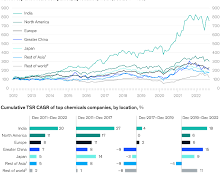In the report titled "India: The Next Chemicals Manufacturing Hub," McKinsey said the country's chemical industry has performed better globally in demand growth and the sector will grow by 11-12% to 27% and 7-10% from 2027 to 20 40, tripling its global market share by 2040. The report confirms the growth in demand for biofriendly products globally, which could benefit India, as it is among the main producers of both agrochemical products and inorganic chemical and petrochemical products.
India is expected to account for more than 20% of incremental global chemical consumption over the next two decades. Domestic demand is expected to increase from $170 billion to $180 billion in 2021 to $850 billion to $1 trillion by 2040.
The growing demand for biofriendly products globally could benefit India, as it is among the leading producers of many chemicals used in such products.
Driven by the evolving geopolitical landscape and the tendency to diversify from existing manufacturing markets, companies are looking to make their supply chains more resilient. With its strong value proposition, India could be a prime destination.
However, India will continue to depend on imports to meet its chemical needs. Of the three main segments of the industry – inorganic, petrochemical (petchem) and specialty – specialty should be a segment of net exports. By 2040, net exports of specialty chemicals are expected to increase about tenfold, from about $2 billion in 2021 to $21 billion.
Due to limited cracking infrastructure and shortages of key raw materials and minerals, both petchem and inorganic segments will be dependent on imports.
While it is clear that India's chemical sector is poised for robust growth, its manufacturing competitiveness is potential, but not yet assured. The report's comparative analysis, which focuses on the chemical sectors of China, Germany, Indonesia, Saudi Arabia, South Korea and Vietnam, shows that although India is more competitive in most cases, these other countries still have competitive advantages over India in some crucial aspects.
Specialty chemicals
With a net trade surplus, the specialty segment is the strongest pillar of India’s chemicals sector. In all, 16 specialty chemicals subsegments perform well on both cost competitiveness and market attractiveness. Two of these subsegments are the following:
Agrochemicals. Agrochemicals in India is currently a $5.5 billion market, growing at a CAGR of 8.3 percent. By 2040, it is expected to account for almost 40 percent of India’s overall chemicals exports.
Food and feed ingredient chemicals. Constituting flavors and fragrances, food and feed additives, and nutraceuticals, this subsegment is a $3 billion market in India, growing at a CAGR of 7 to 9 percent.
Inorganic chemicals
As inorganic chemicals require little processing compared with other segments, the inorganic chemicals segment is predominantly dependent on feedstock availability. India, unfortunately, has a scarcity of raw materials for most chemicals in this segment. However, it has a high demand for many inorganic chemicals, making it an attractive market.
Six subsegments emerge as an opportunity for building an at-scale business in the segment, backed by high growth rate of end-use industries and natural feedstock advantages. Two of these are as follows:
Fluorine. Growing at a CAGR of more than 10 percent, fluorine is expected to become a $4.2 billion market by 2040. Its growth will be driven by rising demand from two of its main end-use industries: pharma and ag-chem.
Sodium and caustic. This subsegment is expected to register CAGR of nearly 10 percent. By 2040, sodium and caustic could become a $13 billion and $11.5 billion market, respectively.
Petchem
In petrochemicals, opportunities are highly dependent on scale and vertical integration capabilities of chemical companies. For example, backward integration at the cracker level makes bulk polymers (polyethylene, polypropylene, PVC, etcetera) score high on market attractiveness and cost competitiveness. However, other companies are better suited to focus on products where feedstock are easily available in the merchant market (for example, C4, C6, and C8 derivatives).



